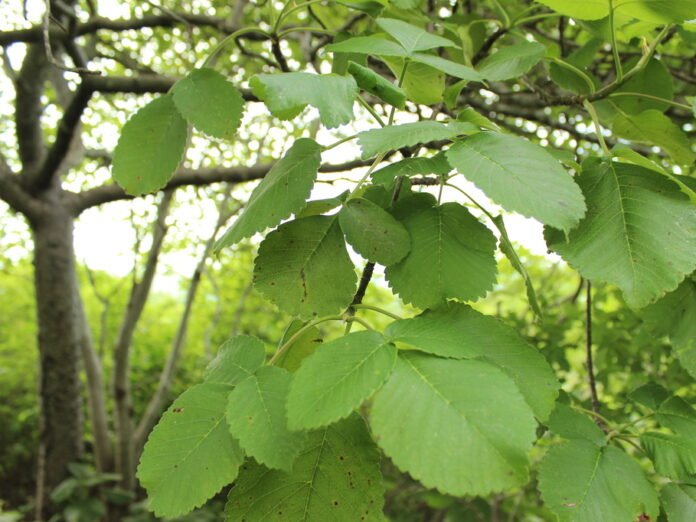No known common English name
Also known as: (None known)
Family: Julianaceae
Origin: Southern Mexico down into Honduras and Guatemala
This is a deciduous (male and female flowers are found in separate trees) shrub or small tree, typically attaining a height of ten to eighteen feet in maturity. Its bark contains tannins – a yellow to brown bitter-tasting, plant tissue substance, consisting of derivatives of gallic acid – used in leather production and ink manufacture, and, as a result, is the source for a traditional red dye. Its sapwood is white and thin, while the heartwood dark brown.
For centuries, it’s been recognized as a medicinal plant and used, as such, in southern Mexico. In fact, the stem bark of the tree is currently used to treat more than 25 ailments. However, as a result of its popularity, and that the most sought after part of the plant is its wrinkled, grayish bark with corky protuberances, as of 2004, the Cuachalalate (perhaps the plant equivalent of the Amur Leopard, Javan Rhino, Sunda Tiger, Sumatran Orangutan, and – even scarcer – a Hawaiian Republican) has been considered an endangered species. However, it can still be purchased online.
Ethnobotanically, by native Indians in the region of its origin, this plant’s bark is thought to cure colic, colitis, fever, gastritis, gastric and peptic ulcers, gastrointestinal cancer, kidney infections, malaria, stomach cancer, strengthen gums, and provide relief for tooth pain.
When applied topically, it is further believed to assist in the healing of vaginal infections and, when mixed with sarsaparilla, help with circulatory ailments. Additionally, the bark – macerated in water – has long been drunk during the day for ulcers, whereas, for wounds, a tea is drunk or the pulverized bark applied to the skin.
Yet more ethnopharmaceutical applications include its employment for liver problems, as a blood purifier, to lower cholesterol, for diabetes, cholelithiasis (gallbladder stones), mouth ulcers, stomach cancer, typhoid fever, and varicose veins. For wounds, a tea is drunk, or the pulverized bark is applied to the skin.
The white gum or resin of the tree is applied to the skin to treat abscesses or boils. The bark decoction is applied topically as a wash for skin problems or baby rashes, bites, hair loss, stings from poisonous animals, puerperal fever, for a displaced uterus, and for “coldness” of the uterus, vaginal secretions and as a general aid for wound healing.
Getting further, as they say, down into the weeds (and rather apt for this column) from a study posted in the National Library of Medicine, I learned that their findings “suggest that the extract of A. adstringens has substantial potential for the treatment of inflammatory colitis.”
Yet another study divulged that its alpha-hydroxymasticadienonic acid (Drop that into your conversation over cocktails tomorrow) demonstrated strong anti-inflammatory activity.
Elsewhere, I noted that it is hypocholesterolemic – a substance or a condition that causes a decrease in cholesterol levels. Beyond that, taken as a hot tea or simple cold drink, used as a mouthwash to strengthen the gums, or applied topically or intra-vaginally for various problems, including rashes and infections.
And if you really wish to impress your friends, co-workers, and family with your ethnobotanical, medicinal chemical knowledge, casually mention that while perusing an article in a past issue of Phytomedicine entitled “Principles of the bark of Amphipterygium adstringens with anti-inflammatory activity,” how that it confirmed your long-held suspicions that masticadienonic and 3α- hydroxymasticadienonic acids were the main constituents of the organic extract from its bark. (Don’t look at me in that way. It was only a suggestion!)
It’s a veritable pharmaceutical cornucopia – and, frustratingly, endangered! But, yet, beyond all of the preceding, recent studies have shown that the active component responsible for the plant properties is an anacardic acid of various applications, including being anti-inflammatory, anti-cancer, anti-microbial, anti-oxidant (which help to tighten the skin, reduce inflammation, and protect against environmental damage), anti-tumor, and anti-ulcer activities. Beyond these benefits, others say that parts of the Cuachalalate tree are anti-fungal and anti-protozoal . . . but – as I wrote (tongue firmly in cheek) in The Medicinal Jungle, it has given indications of being pro something – Conservativism!
Consumed as a tea, it can help relieve pain associated with joint problems, such as osteoarthritis. This analgesic action appears to act on NMDA receptors (specifically, ionotropic glutamate) that play a crucial role in synaptic plasticity, which is the basis of learning and memory. Bring me a couple of cupfuls of that, now!


